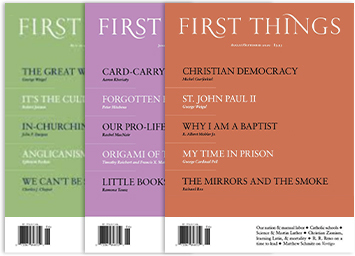Viri Dignitatem:
Personhood, Masculinity and Fatherhood in the Thought of John Paul II
by david h. delaney
emmaus academic, 400 pages, $49.95
If you’re interested in either the thought of St. John Paul II or masculinity in general, this is the book for you. In the first two parts, Delaney brilliantly summarizes and explains John Paul’s philosophy of the human person and his theology of the body. In the latter half of the book, Delaney develops and then defends what he terms John Paul’s theology of masculinity and fatherhood.
A key thing to note about Delaney’s excellent book is that it isn’t a synthesis or presentation of John Paul’s direct thoughts on masculinity, since the latter did not write explicitly on the topic. Instead, Delaney brilliantly uses the principle of complementarity and John Paul’s writings on femininity to infer what the pope likely would have said about masculinity if he had written about it. Perhaps a more accurate subtitle would be “A Wojtyłean Account of Masculinity.”
Despite the methodological limits Delaney faces, he presents a compelling and helpful account of masculinity, faithful to the thought of John Paul. He concludes that masculinity is characterized by initiative love, which complements femininity’s actively receptive love. Thus, men are by nature fitted to be leaders and providers for their families, and they will be most fulfilled if they embrace those roles. This vision of masculinity is especially necessary today to counteract the grave lack of authentic men and fathers in society.
—Matthew McKenna
J. R. R. Tolkien’s Sanctifying Myth:
Understanding Middle-Earth
by bradley j. birzer
regnery gateway, 256 pages, $18.99

Good books that delve into the Catholicism of J. R. R. Tolkien and his works are hard to find. One stellar example, however, is Bradley Birzer’s J. R. R. Tolkien’s Sanctifying Myth, recently reissued by Regnery. The book contains seven chapters, and each chapter examines “a different aspect of Tolkien and his mythology.” Using extensive notes and relying on interviews, letters, and personal remembrances, the book paints a detailed picture of Tolkien the man, presenting his views on topics such as myth, the nature of evil, heroism, and modernity, each filtered through the lens of his Catholicism.
The book was originally written in 2002, and Tolkien scholarship has expanded greatly since that time; nevertheless, there are many unique ideas that set this book apart from its peers. For example, in the chapter on “Middle-earth and Modernity,” Birzer contrasts the symbols of the tree and the machine, demonstrating how Tolkien, a great lover of trees, viewed the tree as a symbol of the premodern world and the machine as a symbol of the modern world. In that same chapter, Birzer addresses Tolkien’s politics, a subject usually overlooked in Tolkien scholarship, and declares the Shire to be “Tolkien’s conception of the ideal agrarian republic.”
All that said, the book does feel incomplete in one respect: Birzer only analyzes the first film in Peter Jackson’s adaptation of The Lord of the Rings, since the book was published before the release of the other two movies. Ideally, it would have been better if the author could have analyzed the complete trilogy. This trifle aside, the book holds up well, and is worthy reading for any fan of Middle-Earth who wishes to dig deeper into the Catholicism that pervades Tolkien’s writings.
—Jason Waskovich




